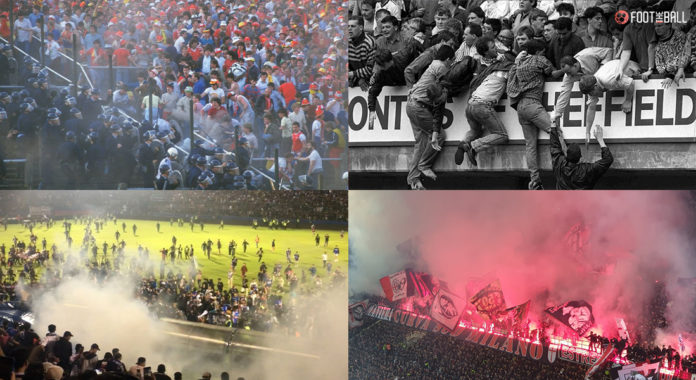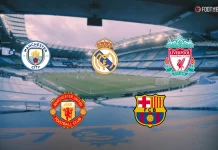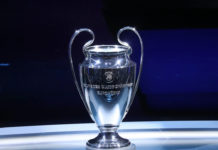Football is about fans. It has been that way for a very long time and it looks to stay that way for the near future.
Although, even if it isn’t a popular opinion out there, fans are also equally part of the negative energy spread out there. It’s not to say that this is the case every time, but more often than not, stadium troubles are usually caused by the fans.
FootTheBall walks through the worst instances of crowd trouble in the history of football.
Heysel stadium incident
The 1985 European Cup Final featured Liverpool—the champions of England and European Cup holders—and Juventus—the champions of Italy and holders of the UEFA Cup Winners’ Cup. The name of the host stadium, Heysel, subsequently become a watchword for hooliganism, incompetence among officials, and structural neglect.
Officials from both clubs had warned that many, mainly Belgians, in the neutral section were likely to sell their tickets to partisan fans. There was a history of violence between English and Italian clubs, and the previous year’s final in Rome had ended in acrimony when Liverpool defeated the local side Roma on penalties. Roma fans, the police, and local hoteliers had all turned on Liverpool fans, who were forced to seek refuge in the British embassy.
Liverpool supporters considered Heysel an opportunity for revenge. The neutral section quickly filled with mainly Italian fans, and all that separated them from the Liverpool section was a flimsy fence. Taunts started, and then missiles began to fly. The fence was quickly breached, and the Liverpool fans advanced. Panic erupted as Juventus supporters and others in the neutral section tried to retreat, only to find their way blocked by a concrete wall. The pressure proved too much, and the structure gave way, crushing the trapped Italian fans and others.
Read more:
France also won 2 penalties in the final 🤷🏻♂️
What are your thoughts? 🤔💭#Messi #Argentina #LionelMessi pic.twitter.com/w1YSyGmZqm
— FootTheBall FC (@FootTheBallFC) May 19, 2023
Oppenheimer stadium disaster
42 supporters lost their lives at the overcrowded Oppenheimer Stadium in Orkney in 1991. It was during a pre-season friendly match between Kaizer Chiefs and Orlando Pirates when fans started rioting, leading to a stampede after Fani Madida had scored Amakhosi’s leading goal.
“It is imperative to remember our fallen heroes and not forget that they died for the love of the beautiful game,” says Chairman Kaizer Motaung about the Orkney disaster. “It is even more important in this 50th year of Kaizer Chiefs to remember all those important days in our history. We should not only celebrate the good but commemorate and remember those who played a role in getting us to where we are today.”
Chiefs legends and players visited the venue in the North West Province to honour and pay tribute to those who lost their lives. They laid flowers at the monument just outside the stadium, which was erected in remembrance of the supporters that passed away in the tragic incident.
San Siro disaster
The 2002/03 Champions League semifinal meeting passed with little incident, as Andriy Shevchenko’s penalty sealed a 1-1 second-leg draw, and Milan progressed to the final on ‘away’ goals. However, the 2004/05 quarterfinals were packed with controversy, as Carlo Ancelotti looked to find a way to overcome Milan again.
After securing a routine 2-0 ‘home’ win, Milan were leading 1-0 in the return game, before the match descended into chaos in the second half as the Inter fans repeatedly threw flares onto the pitch.
As the flares and fireworks continued to land on the San Siro pitch, match referee Markus Merk twice suspended play, and called for a stadium announcement to ask the perpetrators to stop.
However, as smoke filled the stadium, Milan goalkeeper Dida was hit by a flare thrown from the crowd, and Merk immediately abandoned the game.
UEFA officials backed Merk’s decision, with stadium security and police advice blocking a potential restart, and AC Milan were subsequently handed a 3-0 “walkover” by UEFA.
Despite the famous images of superstar players lost in the San Siro fog, the behaviour of the Inter supporters was rightfully condemned by both sides, and Europe’s governing body.
Lima stadium incident
Hosting Argentina on 24 May 1964, Peru were second in the table at the half-way stage of South America’s Olympic qualifying tournament. Confidence was high, but with Brazil awaiting in their last game, Peru realistically needed a draw at least against Argentina.
In quick succession, two spectators entered the field of play. The first was a bouncer known as Bomba, who tried to hit the referee before being both stopped by police and manhandled off the field. The second, Edilberto Cuenca, then suffered a brutal assault.
Within seconds, the crowd were launching a variety of missiles at the police. A couple of dozen more people were trying to reach the pitch. Records state that most victims died from asphyxiation. But what makes this stadium disaster different from others is what happened on the streets outside.
Kolkata derby stampede
The Kolkata Derby has been a historic rivalry between Mohun Bagan and East Bengal, two of the oldest and most prestigious clubs in India. The clash between Bangal-Ghoti is the pinnacle of Asian football rivalries. It has also been considered part of FIFA’s Classic Rivalries.
On 16 August 1980, Eden Garden witnessed the darkest day of this rivalry when they squared off for a Calcutta Football League match. On that day, a total of 16 fans lost their lives due to mayhem in the stands.
Dilip Palit, who started for East Bengal as an atypical right-back, fouled Bidesh Bose, however, referee Sudhin Chatterjee chose not to show Dilip Palit a card. A similar incident occurred in the second half in the 57th minute when Bidesh Ranjan Bose retaliated. As a result, Sudhin Chatterjee chose to send off the Mohun Bagan left winger, but again Dilip Palit escaped punishment. Later, he gave Dilip Palit marching orders to balance his previous decision. As a result, the supporters of the two teams became disoriented.
So many people sought to escape through the stadium’s small gates, which caused a stampede. Unavoidably, lives were lost as a result. The injured and deceased were brought to adjacent hospitals. As per police reports, about 100 people suffered serious injuries, and at least 16 fans lost their lives
Indonesian stadium tragedy
The match between the home team Arema FC and Persebaya Surabaya ended with the former losing 3-2, a huge upset given that Arema had not lost a home game to Persebaya in 23 years, according to police and a local soccer expert. The outcome angered many in the crowd, which consisted almost entirely of Arema supporters after the police had banned Persebaya supporters from attending for fear of violent clashes – which is also known as the Indonesian stadium tragedy.
Agitated Arema FC fans streamed onto the pitch after the match to vent their frustration, prompting clashes with police, who fired tear gas to try and disperse them.
The tear gas sent waves of panic through the crowds, with many caught up in a deadly crash as they tried to escape. Authorities say 125 people were killed, including 32 minors.




